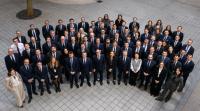
“So are we going to be good ancestors? Or not?”
Social responsibility, sustainability, ESG and SRI are more than buzzwords for the world’s leading pension funds. While some still question the current classifications, taxonomies and regulatory timelines, many of these major institutional investors see it as a way to provide stewardship, serving society as a long-term stakeholder.
The Paris-based World Pension Council (WPC), a financial research and policy think tank, recently hosted discussions on “modern pension management” with representatives of pension superpowers such as Australia, Canada, the UK and the Netherlands.
What became clear at the Paris talks is that pension funds are increasingly leveraging their financial power - like voting power as investors in leading companies - to push sustainability issues in support of a global agenda influenced by the United Nations’ Sustainable Development Goals and other business frameworks such as the “Build Back Better” agenda.
“Many of them are now embracing ESG whilst, simultaneously, accelerating their allocation to private market assets like private equity and infrastructure,” said WPC director Nicolas Firzli. “That’s truly transforming financial markets the world over.”
Advocates of stewardship
“We are really strong advocates of stewardship,” said Helen Dean, CEO of the National Employment Savings Trust, known as Nest, a public retirement fund with 11 million members with 24 billion pounds in assets under management.
“It is one of the most important tools that an investor can use to influence the companies they invest in,” she said. “We take a very holistic approach to it. So we’re looking at voting and our members› long term interest. And we’re looking at having a direct and indirect dialogue with companies we invest in, and we’re contributing to public policy, you know, as that develops, across a range of ESG issues.”
Remi Toucheboeuf, head of investment analytics at BNP Paribas, noted that he sees a steep rise in demand for «actionable ESG data from pension investors».
The ongoing sustainable finance debate presents pension funds with a number of critical dilemmas. One of them, said Gert Dijkstra, senior managing director at APG Asset Management from the Netherlands, is that pension funds incentivise asset managers to build greener or more sustainable portfolios but that the real impact is not always evident.
“We are on one hand incentivised to build dark green portfolios. We have been able to do that easily by selling off all fossil fuel investments. But the big ‘but’ is here: What does it mean for the real economy? I mention this dilemma because I do think that we all, as pension funds, are ideally positioned to facilitate a balanced, controlled energy transition.”
Speaking for the more militant wing of the sustainable finance ecosystem, French sustainable finance pioneer Genevieve Férone-Creuzet, CEO of Prophil and former ESG advisor to California-based teachers pension fund Calpers, noted that 80 percent of the world’s energy still needs to be transitioned.
Balancing willingness with risk
“If all the pension funds of the world were really willing, truly willing to go dark green, all those assets would be very much at risk,” she said. “We have to balance between a true willingness to prepare the future, and at the same time deal with a pool of assets that is very risky.”
A pension fund is just at the core of the dilemma. And good luck to them. There is no other choice,” she said.
“We are running with very heavy shoes,” said Olivier Rousseau of the French National Pension Reserve Fund, referring to constraints that some pension investors face.
Firzli, also cofounder of the advisory board of the World Bank Global Infrastructure Facility, a G20 initiative known as GIF, pointed to the role of the European Investment Bank (EIB), the EU’s suprational financial arm, as an accelerator of public-private financing for positive impact projects.
Bertrand de Mazières, EIB director general for finance who also is known as “the father of green bonds”, underlined the importance of mobilising pension capital in the mix of financing initiatives whose objectives are aligned with the SDGs. Back in 2007, his team at the EIB launched the first “climate awareness bonds”, now known as green bonds.
Path framework at EIB
He explained that the EIB’s interaction with high-emitters or lenders to high-emitters today is guided by what it calls its “Path framework”. The EIB is willing to engage with them on new operations, but with the assurance that they have a decarbonisation or resilience plan and that they apply the appropriate climate disclosure.
“These frameworks force you actually to change your relationship with your clients,” De Mazières said, adding that the EIB is updating its policies for funding ESG projects as well as coal and gas projects for regions that have to abandon economies based on these fuels. “This is work in the making, but it is work that will translate into hundreds of billions of euros.”
Speaking from a more activist perspective, Prophil’s Férone-Creuzet said that intention is key. “The power is in your hands, guys. You said it. You represent a massive part of the assets that are going to be invested in the future. So are we going to be good ancestors? Or not? The only question that matters in terms of fiduciary duties: Are you going to be good ancestors and good shareholders?”













